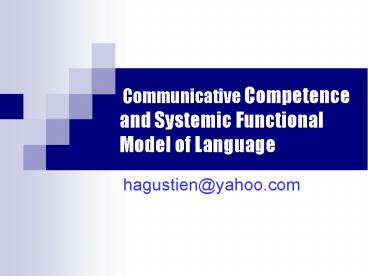Communicative Competence and Systemic Functional Model of Language - PowerPoint PPT Presentation
Title:
Communicative Competence and Systemic Functional Model of Language
Description:
Communicative Competence and Systemic Functional Model of Language hagustien_at_yahoo.com Why we need a CC model Celce-Murcia et al. s effort has been motivated by ... – PowerPoint PPT presentation
Number of Views:210
Avg rating:3.0/5.0
Title: Communicative Competence and Systemic Functional Model of Language
1
Communicative Competence
and Systemic Functional Model of
Language
- hagustien_at_yahoo.com
2
Why we need a CC model
- Celce-Murcia et al.s effort has been motivated
by the belief in the potential in the direct,
explicit approach to the teaching of
communicative skills, which would require a
detailed description of what CC entails in order
to use the sub-components as a content base in
syllabus design.(p.6)
3
Competence
Socio Cultural Comp.
Competence
Strategic
Discourse Competence
Actional Comp.
Linguistic Comp..
4
What does CC entail?
- Discourse Competence
- Linguistic Competence
- Actional Competence
- Socio-cultural Competence
- Strategic Competence (p.10)
5
Discourse Competence
- Discourse competence concerns the selection,
sequencing, and arrangement of words, structures,
sentences and utterance to achieve a unified
spoken or written text. (p.13)
6
Components of Discourse Competence
- COHESION
- Reference, Substutition, Conjuction, Lexical
Chains - DEIXES
- Personal pronouns, Spatial, Temporal, Textual
- COHERENCE
- Thematization, Management of old and new
information - GENRE/GENERIC STRUCTURE
- Narrative, Report, service encounter, etc.
- CONVERSATIONAL STRUCTURE
- How to perform opening, hold the floor,
adjacency pairs, etc.
7
What do we develop?
- The ability to participate in discourse, or
- The ability to communicate, or
- The ability to create spoken and written texts,
or - The ability to negotiate meanings, or
- The ability to exchange nuances of meanings
8
Linguistic Competence
- Syntax
- Morphology
- Lexicon
- Phonology
- Orthography
9
Actional Competence
- Interpersonal Exchange
- Information
- Opinions
- Feelings
- Suasion
- Problems
- Future Scenario
10
Sociocultural Competence
- Social Contextual Factors
- Stylistic Appropriateness Factors
- Cultural Factors
- Non-Verbal Communicative Factors
11
Strategic Competence
- Avoidance or Reduction Strategies
- Achievement or Compensatory Str.
- Stalling or Time-Gaining Str.
- Self-Monitoring Str.
- Interactional Str.
12
The Nature of the CC Model
- Pedagogically motivated (Celce-Murcia)
- Sociocultural theory of language / Language as
communication (Halliday) - Constructivism in sociocultural tradition
(Vygotsky) - Literacy in ELT (Kern)
13
CULTURE
Genre (Purpose)
Situation
Who is involved? (Tenor)
Subject matter
Channel (Field)
(Mode)
Register
TEXT
14
CULTURAL LEVEL
Discourse Semantic Level
Textual
Interpersonal
Lexicogrammatical Level
Ideational
Phonology/ Graphology Level
15
Syarat pengembangan kompetensi komunikatif
- Scaffolding Talks
- Bahasa yang digunakan guru dalam mengelola proses
pembelajaran sebagai - language accompanying action.
16
Zone of Proximal Development
Independent Learning zone
Teacher intervention
Peer-peer interaction
Interactive discourse
17
Peran guru
- Menciptakan pengalaman pembelajaran
- Merancang kegiatan
- Merancang komunikasi
- Berperan sebagai ibu dalam pemerolehan bahasa
alamiah
18
Learning Experiences
19
Literacy Principles
- Interpretation
- Collaboration
- Convention
- Cultural Knowledge
- Problem solving
- Reflection
- Language use
20
Literacy Levels
- Performative Level
- Functional Level
- Informational Level
- Epistemic Level
21
SPOKEN AND WRITTEN LANGUAGECONTINUUM
Most Spoken
Most Written
Language accompanying action
Language as reflection
Spoken Language
Written Language
22
Spoken Written Language
- Spoken
- Language as exchange
- About YOU and I
- Written
- Language as representation
- About others
23
What do people do when communicating?
- They exchange meanings.
24
How do we negotiate?
- Interpersonally
- Logicosemantically
25
Where in the sentence does interpersonal meaning
reside?
- In the Mood area
- Mood Subject Finite
- Mood expresses
- Attitudes
- Feelings
- Judgement
- Etc.
26
Negotiating interpersonally
- A I am sleepy.
- B Are you?
- C I love her.
- D You do, dont you.
- E I cleaned the room!
- D No, you didnt!
27
When is interpersonal negotiation dominant?
- In sustained casual conversations
- Chatting
- Gossiping
- Killing the time
28
Negotiating logicosemantically
- A I am sleepy.
- B Sleepy or hungry?
- A Both, actually.
- C Whats your name?
- D Hartati
- C Where do you live?
- D Jalan Diponegoro.
29
When is logicosemantic negotiation dominant?
- In transactional conversations
- Giving /demanding information
- Givingdemanding goods and services
30
Negotiation in Writing
- Focused on old and new information
- Focused on Theme and Rheme
31
Old and New Information
- Once upon a time, there was an old lady.
- She was very poor, but she was happy.
- She had a handsome son called Ande-Ande Lumut.
- He was a fine young man.
- Many girls liked him.
32
Negotiation is
- The Communication Engine
- The key to discourse competence
33
(No Transcript)
34
(No Transcript)
35
(No Transcript)
36
- Good Luck!

